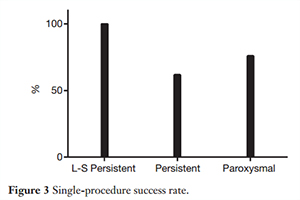Effectiveness and safety of simultaneous hybrid thoracoscopic and endocardial catheter ablation of lone atrial fibrillation
Abstract
Background: We evaluated the safety and effectiveness of the hybrid thoracoscopic endocardial epicardial technique for the treatment of lone atrial fibrillation (LAF).
Methods: Between 2009 and 2012, a cohort of 78 consecutive patients (median age 60.5 years, 77% male) underwent ablation of atrial fibrillation (AF) as a stand-alone procedure using a thoracoscopic, hybrid epicardial-endocardial technique. All patients underwent continuous 7-day Holter monitoring (HM) at
3 months, 6 months, 1 year and yearly thereafter. All patients reached 1-year follow-up. Median follow-up was 24 months [interquartile range (IQR) 12-36].
Results: No death or conversion to cardiopulmonary bypass occurred. No patient demonstrated paralysis of the phrenic nerve. Overall, the incidence of perioperative complications was 8% (n=6). At the end of follow-up sixty-eight patients (87%) were in sinus rhythm (SR) with no episode of AF, atrial flutter (AFL) or atrial tachycardia (AT) lasting longer than 30 seconds and off antiarrhythmic drugs (ADD). Among patients with long-standing persistent AF, 15 (100%) were in SR and off AAD. Success rates were 82% (n=28) in persistent and 76% (n=22) in paroxysmal AF (P=0.08). No patient died and no thromboembolic/bleeding events or procedure-related complications occurred during the follow-up.
Conclusions: Thoracoscopic hybrid epicardial endocardial technique proved to be effective and safe in the treatment of LAF and to represent an important new suitable option to treat stand-alone AF. Our findings need to be confirmed by further larger studies.
Cover






